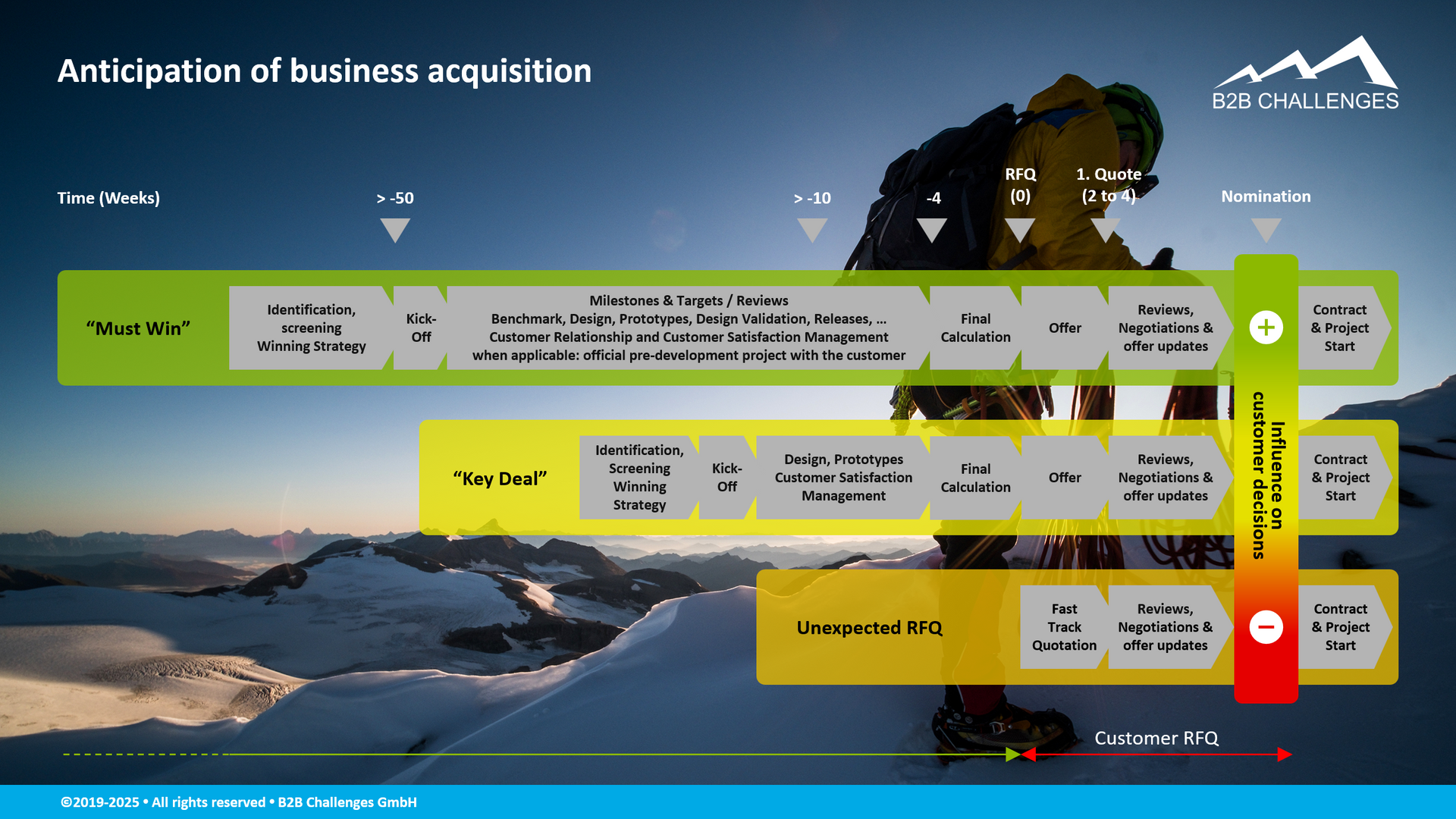Commercial Excellence
Enhancing sales performance by applying best-in-class skills, processes, and tools
Sales processes management
Business Process Management (BPM) mapping varies from one company to another. It depends on the standards applicable to the business and market segments on the one hand, the history, the culture and the structure of the company on the other. A key aspect of commercial processes is the distribution of responsibilities. In this area, it is necessary to ensure that the results delivered are consistent with the organisation's objectives and obligations, whether it concerns, for example, the qualification of new customers, the preparation of offers or the negotiation of contractual conditions. The identification and definition of relevant key performance indicators is of course also crucial.
Pipeline development and acquisition performance
Business acquisition performance is measured in at least two categories. The first category relates to the pipeline of open opportunities. Measuring its total value over several time periods relative to the expected closing dates (e.g. up to the end of the operational reporting period and over successive periods thereafter) provides an assessment of the level of anticipation. Furthermore, the definition of relevant opportunity types and the consequent evaluation of the portfolio ensures that every sales team is maximising its business development drivers. The second category concerns the volume of business won during the operational reporting period and associated key performance indicators.
Anticipation of business acquisition
Effective B2B business development does not only depend on the definition and execution of strategies. It requires every single sales team to optimally perform in the field of business acquisition anticipation. This means identifying strategic business opportunities at the earliest possible stage, launching true cross-disciplinary acquisition projects, defining and executing winning action plans, and proactively engaging with the customers. The aim is, for every significant opportunity, to convince all stakeholders and decision-makers of the concerned customers before they launch their own bidding processes, irrespective of the competition.
Influence on customers’ total cost of ownership
Reducing total cost of ownership (TCO) drives commercial success and fosters strong, lasting customer relationships. By positioning itself as an expert supplier and, ideally, by actively involving itself in the development of its customers' products, a supplier becomes a true strategic partner. This proactive involvement enables it to identify and implement solutions that reduce TCO, thereby offering measurable added value and long-term competitive advantages to its customers. As a result, commercial negotiations will no longer focus solely on price but will be part of a broader value proposition. This approach not only allows the supplier to differentiate itself, but also increases its win rate, profitability, and customer loyalty.
Influence on the design of customer products
The ability to influence the design of customers' products, ideally from the specification phase onwards, is crucial to generating impact and creating value. The opportunities to influence product definition diminish rapidly as design and industrialization progress. Early involvement makes it possible to deliver the best possible contribution to technical choices, cost optimization, and the implementation of innovative or alternative solutions. Establishing close and privileged relationships with customers' technical teams is crucial to ensuring productive collaboration for both parties. This proactive approach not only increases the chances of integrating preferred solutions, but also helps customers optimize total cost of ownership, ensuring mutual long-term success.
Building and growing customer relationships
The systematic development of customer relationships is another key commercial instrument. The process involves careful mapping of all stakeholders, both horizontally and vertically, in order to identify buying centers and influencers. Assessing the attitude, power to influence, level of interest, as well as internal and external relationships of each stakeholder provides all the information needed to identify priorities and measures to develop and/or improve customer relationships. Effective customer relationship management and relevant action plans enable companies to positively influence their customers' decisions, of course in a compliant manner.
IATF 16949 requirements directly linked to customer satisfaction
The IATF 16949:2016 standard - associated to the ISO 9001:2015 standard - places particular emphasis on customer focus, extending far beyond mere product and service compliance by placing customer expectations at the heart of all processes at all levels of the organization, making them a shared responsibility. Sales departments are supposed to be primarily concerned and involved, but the concrete provisions of the IATF 16949 and ISO 9001 standards are not always that well known. It is critical that automotive suppliers embrace these expectations rather than merely avoiding non-compliance, as a strategic customer focus promotes customer satisfaction, continuous improvement, and long-term customer loyalty.
The content of this page is not exhaustive and will be completed from time to time.













